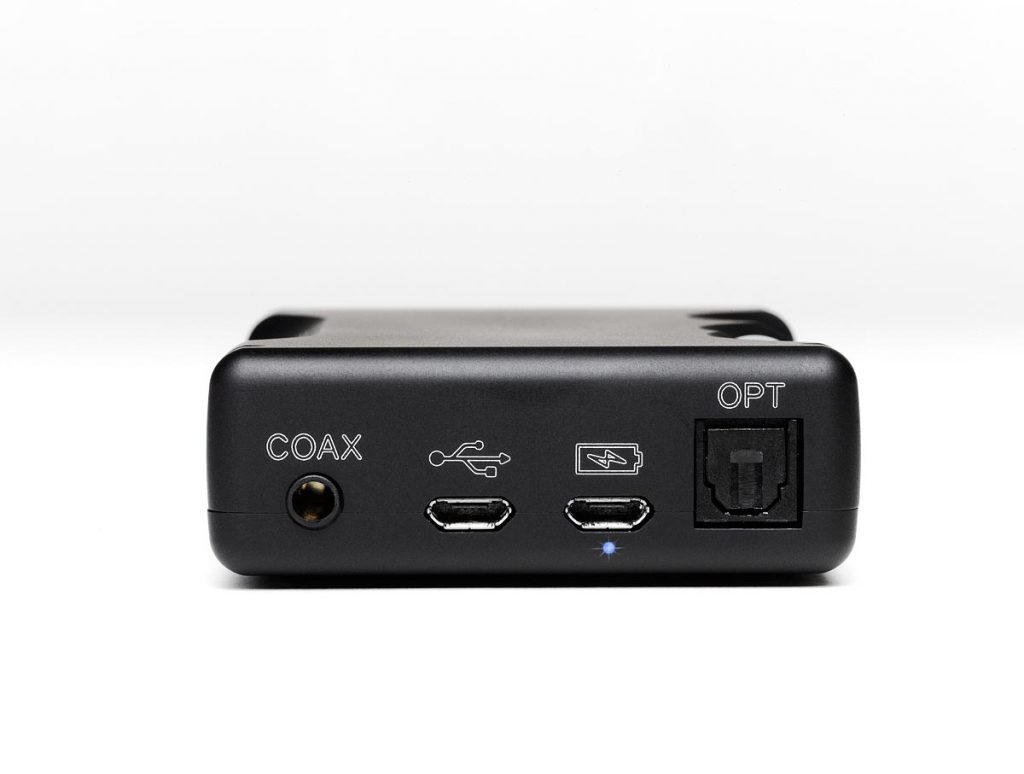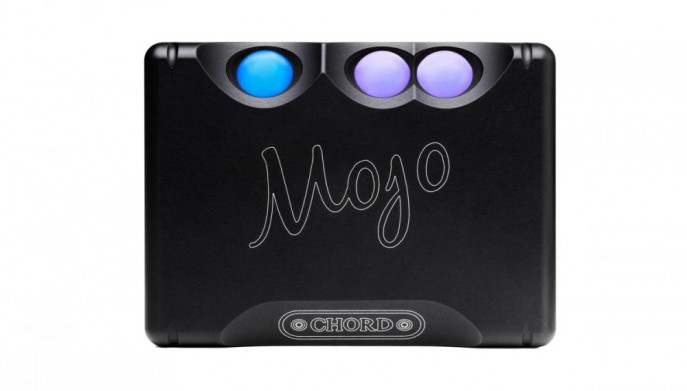Enter the Mojo/Intro:
Chord Electronics Ltd, the UK based audio company behind the highly regarded Hugo DAC/amp and 2Qute DAC, has really floored me with their latest portable amp/DAC combo, the Mojo. The Mojo is priced at $599, which is entry-level for Chord, but features Hugo-like levels of refinement and performance, and it is much more mobile. In fact, “Mojo” is short for “Mobile Joy”! The Chord Mojo is one of the best sounding portable devices I’ve heard to date.
Design:
The engineers at Chord did a great job in designing the Mojo and being able to incorporate much of the Hugo’s technology into a significantly smaller form-factor. The Mojo is smaller than a deck of cards and is able to fit into my pocket with ease, yet it has almost the same specs and capabilities as the Hugo.
Inside the Mojo is a proprietary FPGA DAC which is able to play digital files up to 32-bit/768kHz PCM and up to 512 DSD, which covers just about every digital music format out there and is more than what many full-size DACs can bother to convert, including my own Mytek Stereo192 DSD DAC. Just like the other Chord DACs, the Mojo’s is programmed by Chord themselves and offers better performance with less jitter than many commercially available DAC chips. The DAC’s digital inputs include USB, 3.5mm coaxial, and optical. USB is the primary input and will override the others when it is connected and is the most capable, optical is limited to 192kHz and there are less DSD formats available as well. The Mojo is able to connect to Apple/iOS Devices as well as Android and Windows devices, with a driver being required for the latter. There are no digital outputs on the Mojo and the only outputs for the DAC are the two 3.5mm headphone jacks which go through the amp section of the Mojo. The sample rate of the source is indicated on the power button which lights up accordingly. The LED button is able to display 10 different colors with red being 44kHz, blue for 192kHz, purple for 768kHz, and white being DSD.

The Mojo’s solid-state headphone amplifier has a power output that matches the Hugo and really cool color-changing LED buttons for precise volume control. The headphone amplifier can output up to 720mW into 8 ohms and 35mW at 600 ohms. Output impedance is kept low at 0.075 ohms and the noise floor and distortion are low enough on the amplifier that it can be used to drive just about any headphone from sensitive IEMs to full-size desktop headphones including some planar-magnetics.
Unlike many other portable amplifiers, the volume control on the Mojo is simple to use and has very precise control over the volume, there is no need to complicate things by adding gain or impedance switches, it just works! The LED buttons follow the visible light spectrum and will change from red to violet and eventually white to indicate volume level, similar to how the power button changes colors to indicate sample rate. The volume buttons can either be held down or pressed once, but both give you a clean volume gradient that makes increases and decreases in volume smooth and gradual, without any sudden changes and fine tuning the volume is easier than you’d expect, with great control even when using highly sensitive headphones and IEMs. Volume levels are also remembered by the Mojo when it is shut-off and it will return to the same level when it is powered back on. Additionally, the brightness of the LED lights can be changed by holding both volume buttons while the device is on.
Although the Mojo is not a pre-amp nor a full-on desktop DAC, its headphone output can become a 3V line level output if both volume buttons are held down while the device is being turned on, this allows the DAC to be used to output an analog signal to an external amplifier or pre-amplifier. I was able to connect the Mojo to my Woo Audio 5 and Cypher Labs Sustain84 tube amplifiers this way and was not disappointed at all by the Mojo’s performance as a stand-alone DAC, it is certainly very capable in that regard, especially for a portable product. There is also no added noise or distortion from the amplifier stage, which cannot be bypassed.
The Chord Mojo also has exceptional build quality for a portable device. The all CNC-machined aluminum case is made from a single solid block of aluminum, and it sure feels like it is! Though the case is made up of two parts, they are screwed together underneath and fit so well together that it feels like one whole part. The heavy case is finished in a soft matte black anodized finish and has smooth wedge-like cutouts for the LED-ball buttons and logo as well rounded edges which make the Mojo easy to hold and give it its unique styling. The Mojo is simple, elegant, and is luxurious enough to be considered a proper hi-fi product. There also are no switches, ports, or buttons sticking out beyond the case and the only thing that really grabbed my attention were the tiny rubber feet on the bottom of the case, which will keep the Mojo from scratching when set on a table or desktop, but will probably come off within a few months of owning it. The rest of the Mojo will probably last forever as it is very solidly built.
The lithium polymer (LiPo) battery inside the Mojo takes 4 hours to charge and has a battery life of 8-10 hours. The Mojo was able to last me a full day of work before it ran out power and the LED indicator light below the USB charging port changes colors based on how much power is remaining. The Mojo is able to be used while its charging and there is no change in sound quality or background noise. The temperature however, does increase while charging and the Mojo can get quite warm to the touch, though it never gets too warm and the device will auto shut-off if the internal temperature exceeds specifications.
Equipment:
For this review, I used my Sennheiser HD 800 headphones and my Noble 6C custom in-ear monitors. My source was primarily lossless files fed from my computer via the Mojo’s USB input. I also streamed lossless files from my iPad Air 2 to the Mojo by using either JRiver Media Center’s network streaming app when I was at home or Tidal’s lossless streaming service when I wasn’t. Connection to my computer required me to install the Windows driver which was available from the Chord website and the iPad required an Apple lightning to USB adapter. Both worked flawlessly with the Mojo and there were no issues with playback. As usual, my music choices varied and included just about everything.
Sound:
The Chord Mojo has a clean and neutral sound signature. Both amp and DAC are transparent and free of grain or unnaturalness, with lifelike dynamics and detail. The DAC performs way beyond its price point and handles PCM and DSD files equally well, as both give a natural and effortless presentation, it is very clean and all you hear is the music itself. High resolution DSD albums were constantly being played through the Mojo as it was able to fully flesh out the tiny nuances and details in the recordings with tons of air and presence, with none of the treble glare or coldness sometimes found when playing high-res files on cheaper DACs. DSD albums like Pink Floyd’s Wish You Were Here, Dire Strait’s Making Movies, and The Car’s Candy-O were just some of the classics that I was able to enjoy with the Mojo and Sennheiser HD 800 headphones. The DAC was able to bring out reference-level clarity and detail and the Mojo’s amplifier was able to drive the HD 800s better than many full-size headphone amplifiers could.
The HD 800s were an excellent match with the neutral and open sound of the Mojo and the treble was non-fatiguing even at louder volumes. The soundstage and imaging capabilities of the HD 800 are highly amp and DAC dependent and scale up and improve significantly with better gear. The Chord Mojo was able to bring out the wide, airy soundstage of the Sennheiser HD 800 better than most solid-state amplifiers and instrument placement was spot-on. The HD 800s balanced midrange was focused and detailed with the Mojo, and integrated well with the bass. Both remained neutral but tended to lean towards a slightly warmer and full character, which helped maintain musicality and prevented the Mojo from ever sounding sterile or cold with the HD 800s.
The bass was punchy and tight with excellent low-end extension and slam. It was more than enough for electronic and pop music, and I was surprised by the amount of bass the Mojo was able to extract from the HD 800s, which feel bass-light on many portable amplifiers and even some full-size amp/DACs. My own Mytek Stereo192 DSD DAC for example, has a decent 500mW headphone amplifier built-in and in my opinion, is not as good as the Mojo for driving the HD 800s. The Mytek’s amplifier is somewhat bright and analytical, and is quite unforgiving of poor recordings, which make it an overall bad pairing with the HD 800, and not something I would consider using daily. The Mojo and HD 800 combo is far more enjoyable and much cheaper.
The Mojo being a portable device, excels in driving low-impedance headphones and sensitive IEMs to their full potential. My Noble Audio 6C custom in-ear monitors sounded fantastic with the Mojo and with Tidal streaming, I was able to take my music anywhere I went. Even at higher volume levels, there is zero background noise and the volume control worked well for low-level listening and quieter recordings. The Noble 6Cs warm forgiving character worked well with the Mojo in delivering an easy-to-enjoy sound that worked with pretty much any genre of music. Like with my HD 800s, the Noble 6C and Mojo combination was excellent and offered world-class portable performance that allowed me to enjoy my entire library. The Mojo is one of the few DACs that’s able to extract tons of detail as well as being able to gloss over small imperfections in a recording, never becoming too analytical and missing the whole point of the music.
There are few amplifiers that are able to really bring IEMs to life. Full-size headphone amplifiers like my GSX or WA5 usually have too high of a noise floor and smaller amplifiers and DACs don’t always have the quality I’m looking for. The ALO Continental Dual Mono I heard this summer was easily the best I’ve heard to date with the Noble 6C, and in my opinion, the Chord Mojo comes very very close, and costs about a grand less. The Mojo may lack the sweet extended openness of a tube amplifier, but it has an incredible DAC section and a more powerful solid-state amplifier that allow it to easily compete with products that cost much more.
Conclusion:
The Chord Mojo is one of the best portable devices I have heard at any price. At $600, you get an almost perfect portable amp/DAC that has none of the shortcomings typically found in its competitors. The DAC is amongst the best I’ve heard under $1500 and the amplifier is able to drive headphones better than most $600 headphone amplifiers will. Keep them coming Chord! This one is a winner and a keeper. Highly recommended!
Chord Electronic
Available in the US from: http://www.moon-audio.com/chord-mojo.html















Reply
Reply
Want to join discussion?
Feel free to contribute!